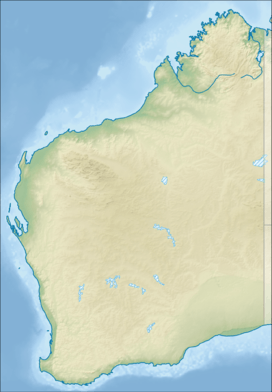Torndirrup National Park
| Torndirrup National Park Western Australia | |
|---|---|
|
IUCN category II (national park) | |
|
The Gap | |
 Torndirrup National Park | |
| Coordinates | 35°05′25″S 117°53′29″E / 35.09028°S 117.89139°ECoordinates: 35°05′25″S 117°53′29″E / 35.09028°S 117.89139°E |
| Established | 1918 |
| Area | 39.36 km2 (15.2 sq mi)[1] |
| Managing authorities | Department of Environment and Conservation |
| Website | Torndirrup National Park |
| See also |
List of protected areas of Western Australia |
Torndirrup National Park is a national park in the Great Southern region of Western Australia (Australia), 400 kilometres (249 mi) southeast of Perth and 10 km (6.2 mi) south of Albany. Torndirrup National Park has many impressive rock formations on the coast. These include the Gap, Natural Bridge and the Blowholes all shaped from the local granite. The park is along the coast on the west side of King George Sound and consists of a range of cliffs, gullies, blowholes, beaches and promontories.
History
The area is composed of three major rock type, one of these being gneiss. The oldest of these was formed 1300-1600 million years ago. This rock type can be seen along the cliff walls of the Gap. The granites were formed later as the Australian Plate collided with the Antarctic Plate 1160 million years ago as molten rock rose to the surface. These granites are visible in the tors atop Stony Hill.
The park was gazetted in 1918, one of the first in Western Australia. It was later named in 1969 taking the name of the Indigenous Australian clan that lived in the area. The first ranger was appointed in 1973.[2] The park is the most often visited park in Western Australia,[3] with approximately 250,000 visitors per annum.[4]
Flora and fauna
A large array of floral species can be found within the park including the Woolly-bush, peppermint tree, Swamp Yate, various Banksias and Karri forest. Coastal plants such as native rosemary, banjine and thick leafed fanflower are found in the heath. The park is also home to the very rare Albany Woolly-bush[5] and the critically endangered Blue Tinsel Lily of which only a single population exists.[6]
Fauna such as kangaroos, bush rats, pygmy possums and short nosed bandicoots are found within the park. Many reptile species are also to be found including Tiger snakes, bardick, children's python and Dugites. In 1876 the rare Dibbler was found in the park.[7] Birdlife includes honeyeaters, wattlebirds, Button Quail, Western Rosella and a variety of sea birds.[8] Whales and seals can be seen from the cliffs of the park in the correct season.
The rare and ancient Main's assassin spider, currently listed as threatened, was found to inhabit the park during a survey conducted in 2008.[9]

Facilities
No entry fee is required to enter the park. Access to the park is via Frenchman Bay Road which is sealed and well sign-posted. Access to most features is via sealed roads. No other facilities exist within the park but barbecues, tables, shops and toilets can be found nearby at Frenchman Bay.
The park has numerous walks mostly of a distance of less than 1,500 metres (4,921 ft), including the Jimmy Newhills walk and the Stony Hill Heritage Trail walk. The longest trail is the 10 km (6.2 mi) Bald Head Walk along Flinders peninsula finishing at Bald Head at the eastern edge of the park.[10]
See also
- Protected areas of Western Australia
References
- ↑ "Department of Environment and Conservation 2009–2010 Annual Report". Department of Environment and Conservation. 2010. p. 48. ISSN 1835-114X.
- ↑ "Department of Environment and Conservation -Park Finder - Torndirrup National Park". 2008. Retrieved 26 September 2010.
- ↑ "About Australia - Torndirrup National Park". 2010. Retrieved 16 May 2010.
- ↑ "Australian Explorer - Torndirrup National Park". 2009. Retrieved 16 May 2010.
- ↑ "Department of Environment - Species profile and threats database". 2010. Retrieved 16 May 2010.
- ↑ "Department of Environment - Species profile and threats database". 2010. Retrieved 16 May 2010.
- ↑ "Parkfinder - Torndirrup National Park". 2009. Retrieved 16 May 2010.
- ↑ "Peasetakemeto - Torndirrup National Park". 2009. Retrieved 16 May 2010.
- ↑ "Verve Energy Media release - Exciting find of rare assassins spider found on WA South Coast" (PDF). 2008. Retrieved 12 November 2010.
- ↑ "Australian National Parks - Torndirrup National Park". 2009. Retrieved 16 May 2010.
| Wikimedia Commons has media related to Torndirrup National Park. |
- Protected areas of Western Australia
